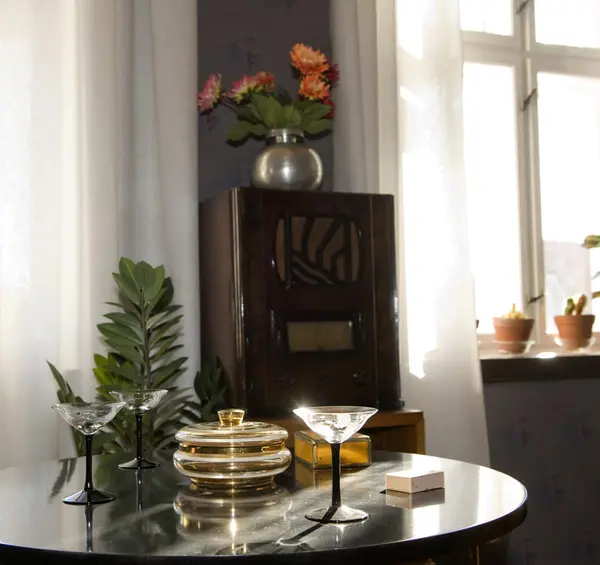-
Cocktails er servert i Evelyns stue, 1935 Anne-Lise Reinsfelt | Norsk Folkemuseum
The year is 1935. It is an age of contradictions – politically, socially and culturally. It is the beginning of the social democratic era in Norway, but Fascism and Nazism are advancing throughout Europe.
It is still an age of economic hardship, a time of crisis, unemployment and housing shortages, but there is hope for a better future.
There is belief in liberation and progress, but also a fear of the decline of morals, a time for intellectual radicalism and conservatism, a time for rationality and for mysticism. It is the age of both psychoanalysis and the “Oxford group”.
“Evelyn Berg” is a modern woman, with modern ideas about how the home should be decorated and furnished. Her flat was refurbished in the early 1930s according to the ideals of Functionalism but the dream of large windows through which sun light could flood, could not be fulfilled in this apartment.
Functionalism encouraged the use of strong and contrasting colours that would enforce details and give the rooms individuality and character. Ornaments and decor without purpose, without a function, were unacceptable. Many felt that this was a touch extreme and most modern houses and interiors used calmer colours and had more decorative touches. Pure Functionalistic interiors almost only existed in the homes of certain architects and designers.
The modern people of the 1930s expressed the new age by choosing lamps, vases and furniture that were easily affordable. In her living room, “Evelyn Berg” has a PH-lamp, designed by Danish architect, Mr Poul Henningsen, and an ultramodern steel rod chair. Flowers were “allowed”, but should be simple and easy to care for, with clean lines to compliment the minimal functional styling. Cacti and tulips were therefore preferred. “Evelyn Berg” has a gramophone and a radio – pianos were considered bourgeois.
Floors had to be durable and easy to clean, and preferably be made of linoleum. The walls should be painted or wall-papered, preferably be monochrome, but could have a simple geometric pattern. The curtains should give a simple and clean impression, ideally be monochrome and reach from floor to ceiling.
The functions of the rooms are clear albeit the apartment itself does not fulfil all the requirements of true Functionalism. The hallway is used to receive guests and also as a cloakroom. People no longer sleep in the kitchen or in the living room. Instead there is a separate bedroom where one washes and dresses and where one also keeps one’s clothes
“Evelyn Berg” is a fictional character, but she has many role models both in literature and in real life. She is in no way representative of a typical woman of the 1930s but she embodies the tendencies of the time. Her home has been constructed based upon the book “How We Want to Live” from 1935 by the architect, Mr Bernt Heiberg and upon the Norwegian magazine “House and Garden”.
